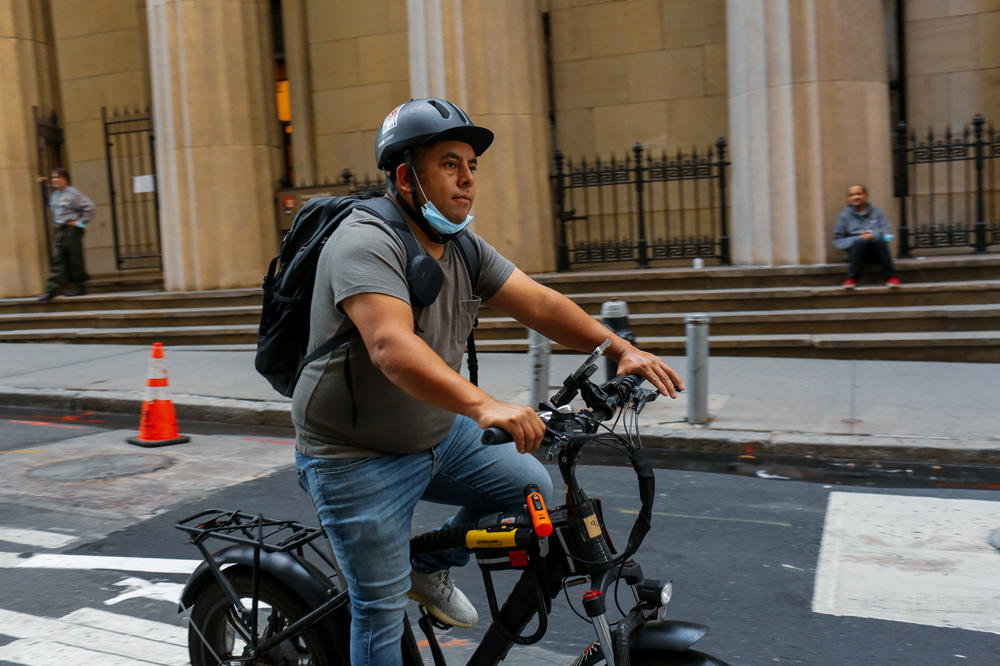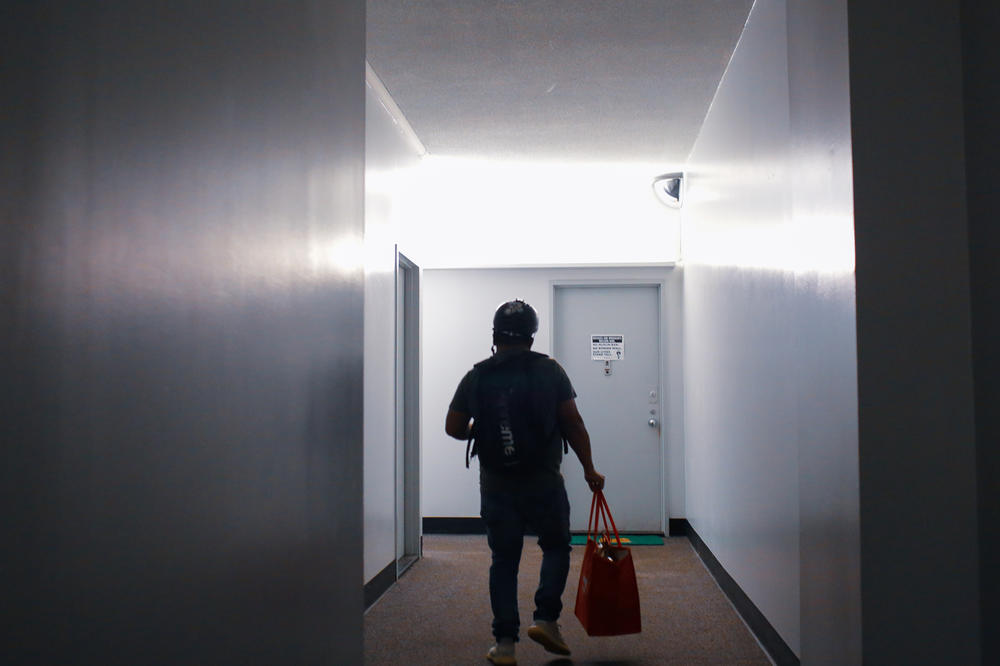Section Branding
Header Content
Ordering food on an app is easy. Delivering it could mean injury and theft
Primary Content
Gustavo Ajche is about to begin his shift in Lower Manhattan. He makes sure his e-bike is powered up and his iPhone mounted to his handlebars, then nods approvingly.
"Now we're gonna connect it to the app," he said. "I'm gonna start working."
Ajche's story is familiar among the thousands of bike-propelled delivery workers that have overtaken New York City since the pandemic: An immigrant from Guatemala and father of two, he was laid off from his pizza delivery job during the pandemic, so he switched to delivering food for apps like DoorDash and GrubHub. That meant, he said, swapping a human boss for something else.
"Patron Fantasma," said Ajche, who is 38. "It's like a ghost boss."
The food delivery apps, which also include UberEats, position themselves as a "frictionless" way to order food with a few taps of a phone. But there's plenty of friction for the delivery workers cycling through New York at a breakneck pace, whether weaving around traffic at high speeds, wiping out on a bike, or sometimes even fending off attackers.
Meanwhile, the food delivery apps monitor their every move, pressuring them to go faster and faster to hungry customers awaiting orders from the comfort of their homes. All to earn a few hundred dollars a day, if they're lucky.
"When the customer sees their bill from GrubHub or DoorDash, they see different fees and cost of the item, and tip, but what's not listed on the bill is the human toll on the workers," said Do Jun Lee, an urban studies professor at Queens College who has extensively studied the city's delivery workers. "What they have to pay out of pocket. The robberies and assaults they experience. The broken leg they got while delivering."
Half of workers report having their e-bikes stolen
With many people sticking to habits formed when the pandemic kept them inside, customers orders on the delivery apps keep flowing in and competition among the companies, and among the workers, is fierce. Speed, it turns out, is a premium.
"Before the pandemic I used a regular bike," Ajche said. "But now, you need an Arrow or you won't be able to work."
The Arrow is a battery-powered mountain bike that can go up to 30 mph. It usually cost around $1,800 and has become the standard mode of transportation of choice among the estimated 65,000 food delivery workers racing around the city.
"I like to compare it to an extreme sport," he said. "You keep going and going and keep pushing and pushing until you can't push anymore."
Before COVID-19 hit, the city fined workers and impounded their e-bikes, citing how dangerous they can be, but the the pandemic turned them from perceived scourge to essential infrastructure.
That was welcome news to Ajche, but it was accompanied by something troubling: an uptick in bike robberies and assaults of delivery workers.
A recent survey of 500 delivery workers conducted by the Worker's Justice Project and Cornell University found that more than half have had an accident or crash while doing a delivery. Three in four delivery workers said they paid for medical care from a work-related injury out of their own pocket. Half said they have had their bikes stolen.
Now, during late night shifts, delivery workers cross bridges in large packs to ward off would-be thieves, Ajche said.
In the first nine months of 2021, ten delivery cyclists have died, according to the Worker's Justice Project. That includes one who died after a hit and run in Brooklyn and another worker who was stabbed to death.
"You never know who's going to confront you. You never know who is going to try to steal your bike. Maybe somebody with a gun," Ajche said.
The rise in robberies and injuries led Ajache to help form a group called Los Deliveristas Unidos, vaulting Ajche from part-time construction worker and DoorDasher, as some call themselves, to the public face of an organized movement to unify delivery workers around the common cause of better protections and safety.
New protections from the city and companies fall short of workers' needs
The group successfully lobbied the New York City Council to set new pay minimums and require restaurants to let workers use their bathrooms, which was previously not allowed.
"OK, this is good," Ajache said of the new protections. "But what about security? Security was the main problem on the street."
Ajche wants better lighting installed on dark bridges and he wants the NYPD to take crimes against delivery workers more seriously. He thinks there should be a law to penalize perpetrators of crimes against app couriers.
Last year, Ajche fell after his bike wiped out on black ice and badly injured his knees. He notified the tech companies.
"If you need assistance, we can call 911. But that's the best we can do for you. That's what they say to you," he recalled.
That made him sad, he said, "because you're working for them."
In response to these growing safety concerns, DoorDash on Wednesday announced a new tool on the app called SafeDash in six cities including New York, in partnership with security company ADT. The app offers "reassurance calls" if a DoorDasher feels unsafe and an easy way to contact 911 if a worker encounters danger.
The company told NPR if a worker suffers an injury while delivering for the company, they may be eligible for accident insurance. But the protections do not cover damage to bicycles and may not apply if a courier is delivering food for multiple apps, which many do.
A plea to people ordering food: have empathy
Ajche says his message to people ordering food through the apps is this: Workers are often pulling 12, 13, 14 hour shifts for maybe $200 or $300 a night. They are moving, he said, as fast as they can.
"They're calling you, they're texting you, 'where is my food'?" Ajche said. "And then sometimes it isn't the delivery worker's problem that the food is getting to you cold," he said. "If customers realized how many orders we have in our bag at once, maybe they'd understand what we're going through."
Copyright 2021 NPR. To see more, visit https://www.npr.org.








